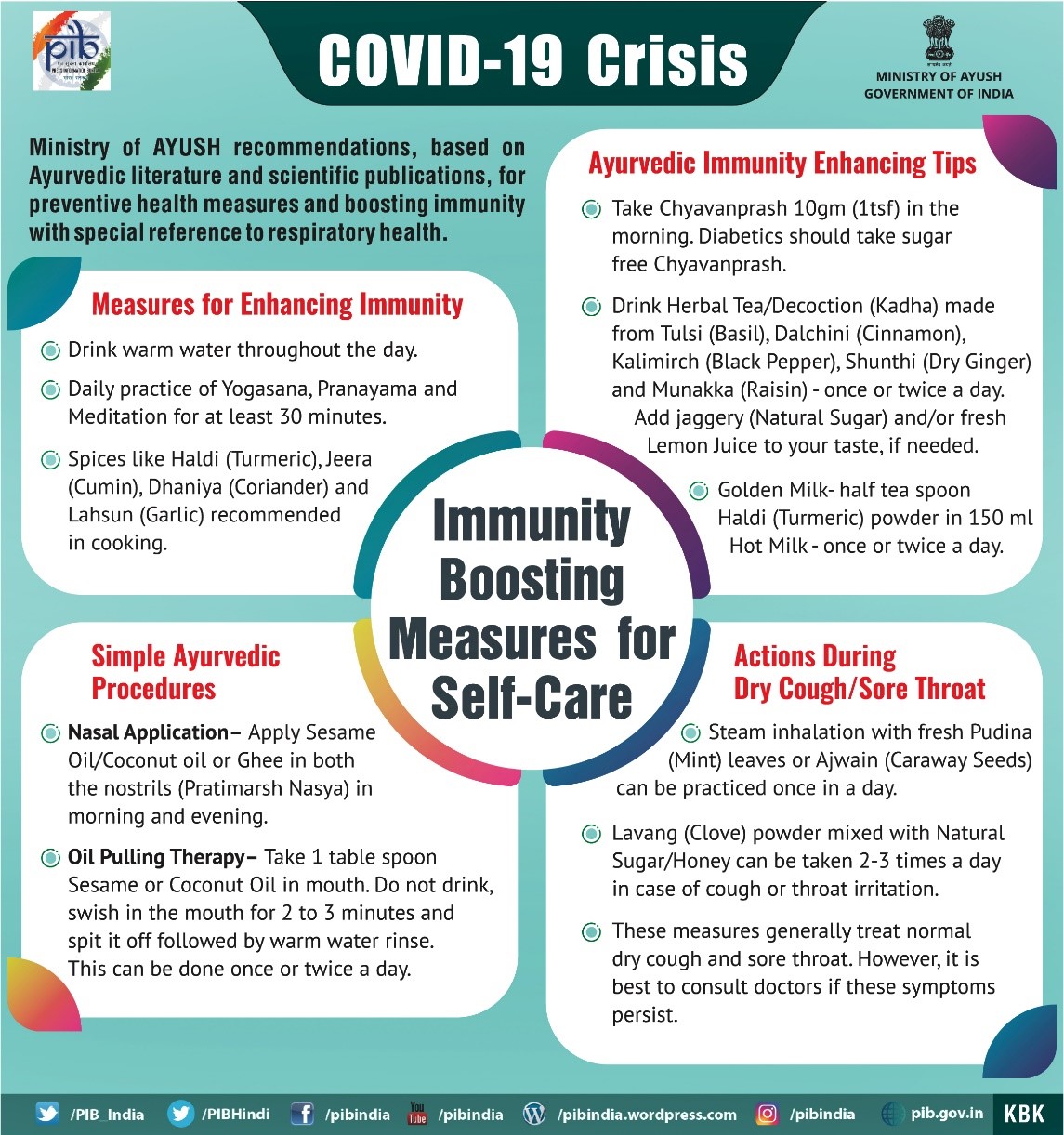April 10th, 2020 PIB:- Download PDF Here
TABLE OF CONTENTS
1. AYUSH reiterates immunity boosting measures 2. Bharat Padhe Online 3. Central Institute of Plastics Engineering & Technology (CIPET) 4. Personal Protective Equipment (PPE) 5. Piezoelectricity
1. AYUSH reiterates immunity boosting measures

Background
- In the wake of the COVID 19 outbreak, entire mankind across the globe is suffering. Enhancing the body’s natural defence system (immunity) plays an important role in maintaining optimum health.
- We all know that prevention is better than cure. While there is no medicine for COVID-19 as of now, it will be good to take preventive measures which boost our immunity in these times.
- Ayurveda’s extensive knowledge base on preventive care, derives from the concepts of “Dinacharya” – daily regimes and “Ritucharya” – seasonal regimes to maintain a healthy life.
Context
- Union HRD Minister launches ‘Bharat Padhe Online’ campaign to invite ideas to improve online education ecosystem
Details
- The campaign aims to invite the best brains in the country to share suggestions/solutions directly with the HRD Ministry to overcome constraints of online education.
- Further educators across the country can also come forward to contribute with their expertise and experience in the field of education.
- Thus limitations of the current online education scenario of India and challenges they face in traditional classrooms can be addressed through online education.
3. Central Institute of Plastics Engineering & Technology (CIPET)
- It was established in 1968 by Government of India with the assistance of United Nations Development Programme (UNDP) at Chennai.
- The main objective of setting up of the institute was to develop manpower in different disciplines of Plastics Engineering & Technology as no similar institute was in existence in the country.
- International Labour Organization (ILO) served as the executing agency.
- CIPET is a premier national institution under the Ministry of Chemicals & Fertilizers, Govt. of India fully devoted to Skill Development, Technology Support Services, Academic and Research (STAR) in all the domains of plastics
Objectives
- To provide qualified plastics professionals at various skill levels through academic Long term, short term, Skill Development & Entrepreneurship development programs in the field of Polymer Science & Technology.
- To offer Technology Support & Consultancy Services in the areas of Plastics Processing, Testing, Quality Control, Inspection, Design, Tool Room, CAD/CAM/CAE, Calibration & Application Development.
Context
- CIPET Institutes/Centres contribute Rs 86.5 lakh to local authorities/governments for COVID-19 relief work
4. Personal Protective Equipment (PPE)
- They are protective gears designed to safeguard the health of workers by minimizing the exposure to a biological agent.
- Components of PPE are goggles, face-shield, mask, gloves, coverall/gowns (with or without aprons), head cover and shoe cover.
Context
- PMO reviews efforts of eleven Empowered Groups towards tackling COVID-19
- The production of PPEs is being ramped up and capacity building for healthcare personnel is being ensured.
- Piezoelectricity (also called the piezoelectric effect) is the ability of certain materials to generate an electric charge in response to applied mechanical stress.
- The word Piezoelectric is derived from the Greek word Piezein, which means to squeeze or press, and piezo, which is Greek for “push”.
- The piezoelectric effect is a reversible process: materials exhibiting the piezoelectric effect (the internal generation of electrical charge resulting from an applied mechanical force) also exhibit the reverse piezoelectric effect, the internal generation of a mechanical strain resulting from an applied electrical field.
- French physicists Jacques and Pierre Curie discovered piezoelectricity in 1880
Piezoelectric Materials
There are many materials, both natural and man-made, that exhibit a range of piezoelectric effects.
- Some naturally piezoelectric occurring materials include Berlinite (structurally identical to quartz), cane sugar, quartz, Rochelle salt, topaz, tourmaline, and bone (dry bone exhibits some piezoelectric properties due to the apatite crystals, and the piezoelectric effect is generally thought to act as a biological force sensor).
- An example of man-made piezoelectric materials includes barium titanate and lead zirconate titanate.
Applications
- Piezoelectricity is exploited in a number of useful applications, such as the production and detection of sound, piezoelectric inkjet printing, generation of high voltages, electronic frequency generation, microbalances, to drive an ultrasonic nozzle, and ultrafine focusing of optical assemblies.
- It forms the basis for a number of scientific instrumental techniques with atomic resolution, the scanning probe microscopies, such as scanning tunneling microscope (STM), Atomic force microscopy (AFM)
- It also finds everyday uses such as acting as the ignition source for cigarette lighters, push-start propane barbecues, used as the time reference source in quartz watches
Context
- Researchers from Institute of Nano Science and Technology (INST), Mohali an autonomous institute under the Department of Science & Technology, have made computer based designs of nano-materials with superhigh piezoelectricity which can be the building blocks of futuristic nano-electronics for applications like ultrathin, next-generation nano-transistors.
- The research demonstrated induction of superhigh out-of-plane piezoelectricity via stacking one monolayer over the other in the 2D nanostructure.
Details
- The induction of this phenomenon is based on two-dimensional van der Waals Heterostructure (vdWH) comprising of 2D monolayers
- The vdWH is a new approach in materials design where different monolayers having complimentary properties are combined together to surmount their intrinsic limitations.
- When two monolayers are stacked over one another to constitute a vdWH, various factors affect the electronic properties.
- The dipoles arising at the interface due to the large charge density difference between the two constituent monolayers extend out into the interlayer region, which result in such an ultrahigh value in out-of-plane piezoelectricity.
April 10th, 2020 PIB:- Download PDF Here
| Related Links | |||
| UPSC 2020 | Government Exams | ||
| UPSC Current Affairs Quiz | UPSC Prelims Exam | ||
| UPSC Monthly Magazine for Current Affairs | IAS Eligibility | ||
Read more PIB articles here.


Comments